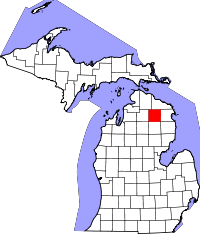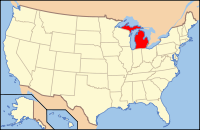- Montmorency County, Michigan
-
Montmorency County, Michigan
Seal
Location in the state of Michigan
Michigan's location in the U.S.Founded 1881 Seat Atlanta Area
- Total
- Land
- Water
562.44 sq mi (1,457 km²)
547.63 sq mi (1,418 km²)
14.81 sq mi (38 km²), 2.63%Population
- (2000)
- Density
10,315
18/sq mi (7/km²)Website www.montmorencycountymichigan.us Montmorency County is a county in the U.S. state of Michigan. As of the 2000 census, the population was 10,315. The county seat is Atlanta.[1] In 1840, it was first named "Cheonoquet" after a well known Chippewa (also known as Ojibwa) Chief, whose name meant Big Cloud. Cheonoquet took part in Indian treaties in 1807, 1815, 1825 and 1837.[2][3] In 1843, the county was renamed for the Count Morenci, who aided the colonies in the war with England. The county was organized in 1881.[4] The reason for the change in spelling is subject to some dispute.[3] See List of Michigan county name etymologies. The name Montmorency probably means Mountain Moor. Montmorency is very much a boggy land or moor that is at the top of a broad mount or highland. When the county was formed in 1881, some land area was taken from Cheboygan and Alpena counties. Three townships were divided, namely Briley, Montmorency and Rust. By 1901 Albert, Hillman and Wheatfield were added. Brush Creek, now known as Hillman, was the first county seat. In 1891 the county seat was moved to Atlanta.[5]
Montmorency County is home to Michigan's most endangered species and one of the most endangered species in the world: the Hungerford's crawling water beetle. The species lives in only five locations in the world, two of which are in Montmorency County, both inside the Mackinaw State Forest. The first site is along the East Branch of the Black River where two adult beetles were found in surveys in 1989 and two more again in 1996. In July 1999, six additional adult beetles were identified in the county living in Van Hetton Creek. This latter find was significant as it represented a new location beyond those originally identified when the Hungerford's crawling water beetle was categorized as endangered on March 7, 1994, under the provisions of the U.S. Endangered Species Act. The Van Hetton Creek sighting therefore provides the possibility that more of these very rare beetles might be found elsewhere in Montmorency County.
Contents
Geography and economics
- According to the 2000 census, the county has a total area of 562.44 square miles (1,456.7 km2), of which 547.63 square miles (1,418.4 km2) (or 97.37%) is land and 14.81 square miles (38.4 km2) (or 2.63%) is water.[6]
- Most of the county is covered by state forest land. There is and has been an abundance of lakes. Dairy products and dry beans are an important part of the county's agricultural production. Service industry and retail trade relating to tourism make up most of the economic base in this rural area.[7] Boating, fishing, and other outdoor activities are offered in abundance.[8]
- Glaciers shaped the area, creating a unique regional ecosystem. A large portion of the area is the so-called Grayling outwash plain, which consists of broad outwash plain including sandy ice-disintegration ridges; jack pine barrens, some white pine-red pine forest, and northern hardwood forest. Large lakes were created by glacial action.[9]
- The county is considered to be part of Northern Michigan.
Adjacent counties
- Presque Isle County - northeast
- Alpena County - east
- Alcona County - southeast
- Oscoda County - south
- Crawford County - southwest
- Otsego County - west
- Cheboygan County - northwest

Cheboygan County Presque Isle County 
Otsego County 
Alpena County  Montmorency County, Michigan
Montmorency County, Michigan 

Crawford County Oscoda County Alcona County Transportation
Michigan State trunklines
Michigan State trunkline business loops
 Business M-32 is short, disconnected route in the village of Hillman.
Business M-32 is short, disconnected route in the village of Hillman.
Montmorency County intercounty highways
Demographics
As of the census[10] of 2000, there were 10,315 people, 4,455 households, and 3,047 families residing in the county. The population density was 19 people per square mile (7/km²). There were 9,238 housing units at an average density of 17 per square mile (7/km²). The racial makeup of the county was 98.36% White, 0.24% Black or African American, 0.36% Native American, 0.10% Asian, 0.10% from other races, and 0.84% from two or more races. 0.65% of the population were Hispanic or Latino of any race. 28.3% were of German, 12.7% English, 9.5% American, 8.8% Irish, 7.6% Polish and 7.4% French ancestry according to Census 2000. 98.1% spoke English as their first language.
There were 4,455 households out of which 22.50% had children under the age of 18 living with them, 58.10% were married couples living together, 7.10% had a female householder with no husband present, and 31.60% were non-families. 27.50% of all households were made up of individuals and 15.40% had someone living alone who was 65 years of age or older. The average household size was 2.29 and the average family size was 2.75.
In the county the population was spread out with 20.30% under the age of 18, 5.90% from 18 to 24, 20.90% from 25 to 44, 29.10% from 45 to 64, and 23.90% who were 65 years of age or older. The median age was 47 years. For every 100 females there were 96.60 males. For every 100 females age 18 and over, there were 94.90 males.
The median income for a household in the county was $30,005, and the median income for a family was $34,784. Males had a median income of $30,910 versus $19,299 for females. The per capita income for the county was $16,493. About 9.80% of families and 12.80% of the population were below the poverty line, including 20.00% of those under age 18 and 8.70% of those age 65 or over.
Government
The county government operates the jail, maintains rural roads, operates the major local courts, keeps files of deeds and mortgages, maintains vital records, administers public health regulations, and participates with the state in the provision of welfare and other social services. The county board of commissioners controls the budget but has only limited authority to make laws or ordinances. In Michigan, most local government functions — police and fire, building and zoning, tax assessment, street maintenance, etc. — are the responsibility of individual cities and townships.
Montmorency County elected officials
- Prosecuting Attorney: Terrie Case
- Sheriff: Don Edwards
- County Clerk: Cheryl A. Neilsen
- County Treasurer: Wanda M. Teets
- Register of Deeds: Teresa Walker
- Drain Commissioner: Jim Zavislak
- Road Commissioners: Joseph R. LaFleche; Theodore Orm; Linda Hicks
(information as of August 2008)
Cities, villages and townships
- Hillman, village
- Lewiston, CDP
- Loud Township
Wheatfield was changed to Vienna. Avery and Loud Townships were added.[11]
Recreation
- Montmorency County is noted as the "Elk Capital of Michigan".
- Rainbow trout, brook trout, steelhead, perch, bass and other pan fish abound. The county is a hotbed of fly fishing and angling on the edge of some world class streams and rivers.
- As is true in some other rural parts of Michigan, White tail deer hunting is very popular local activity and the firearms deer opener (November 15) is noted as a holiday to some residents. Most of the land in Montmorency County is owned by state and federal government, making the county a popular hunting area.[12]
- Snow shoeing, cross-country skiing and snow mobile riding are activities that fit right in to the local winter weather and topography. Also, the Sno*Drift rallying race is held on snowy surfaces in January.
- Morel mushroom hunting is a big event here.
- There are many recurring events throughout the area.[13]
ORV/ATV and snowmobile trails are considered some of the best in the state of Michigan. Montmorency county is one of a few counties that allow ATVs on public county roads. Thus creating access for fuel, food and various hotels to both Hillman and Atlanta. The main trail system incorporates a scenic Elk tour and various levels of ATV trails.
Newspapers
- The official newspaper of record is the Montmorency County Tribune.[14]
See also
- National Register of Historic Places listings in Montmorency County, Michigan
Notes
- ^ "Find a County". National Association of Counties. http://www.naco.org/Counties/Pages/FindACounty.aspx. Retrieved 2011-06-07.
- ^ Montmorency County genealogical page.
- ^ a b Montmorency County home page.
- ^ Clarke Historical Library, Central Michigan University, Montmorency County
- ^ Montmorency County genealogical page
- ^ "Census 2000 U.S. Gazetteer Files: Counties". United States Census. http://www.census.gov/tiger/tms/gazetteer/county2k.txt. Retrieved 2011-02-13.
- ^ Montmorency County economic profile.
- ^ Montmorency County tourism profile, Michigan State University extension service
- ^ Michigan regional geology.
- ^ "American FactFinder". United States Census Bureau. http://factfinder.census.gov. Retrieved 2008-01-31.
- ^ Montmorency County genealogical page 1903 Montmorency County Atlas.
- ^ Economic profiler, Montmorency County
- ^ List and calendar of events
- ^ Montmorency County Tribune.
External links
- Atlanta, Michigan Chamber of Commerce, includes calendar of local events.
- Clarke Historical Library, Central Michigan University, Montmorency County.
- Economic profiler, Montmorency County
- Elk Country Animal Shelter.
- Enchanted forest, Northern Michigan source for information, calendars, etc.
- List and calendar of events throughout the county.
- Lewiston, Michigan Chamber of Commerce, includes calendar of local events and list of local official addresses, phone numbers.
- Montmorency County genealogical page.
- Montmorency County home page, including history of the county.
- Montmorency County prosecuting attorney.
- Montmorency County Tribune.
- Soil survey of Montmorency County -- lots of history and other current information, too -- U.S. Department of Agriculture, Michigan State University Extension Service.
Municipalities and communities of Montmorency County, Michigan Village Townships Unincorporated
communitiesFootnotes ‡This populated place also has portions in an adjacent county or counties
Northern Michigan Topics Major Highways Central cities Satellite cities Region Outlying regions Counties See also: MichiganCategories:
MichiganCategories:- Michigan counties
- Montmorency County, Michigan
Wikimedia Foundation. 2010.


